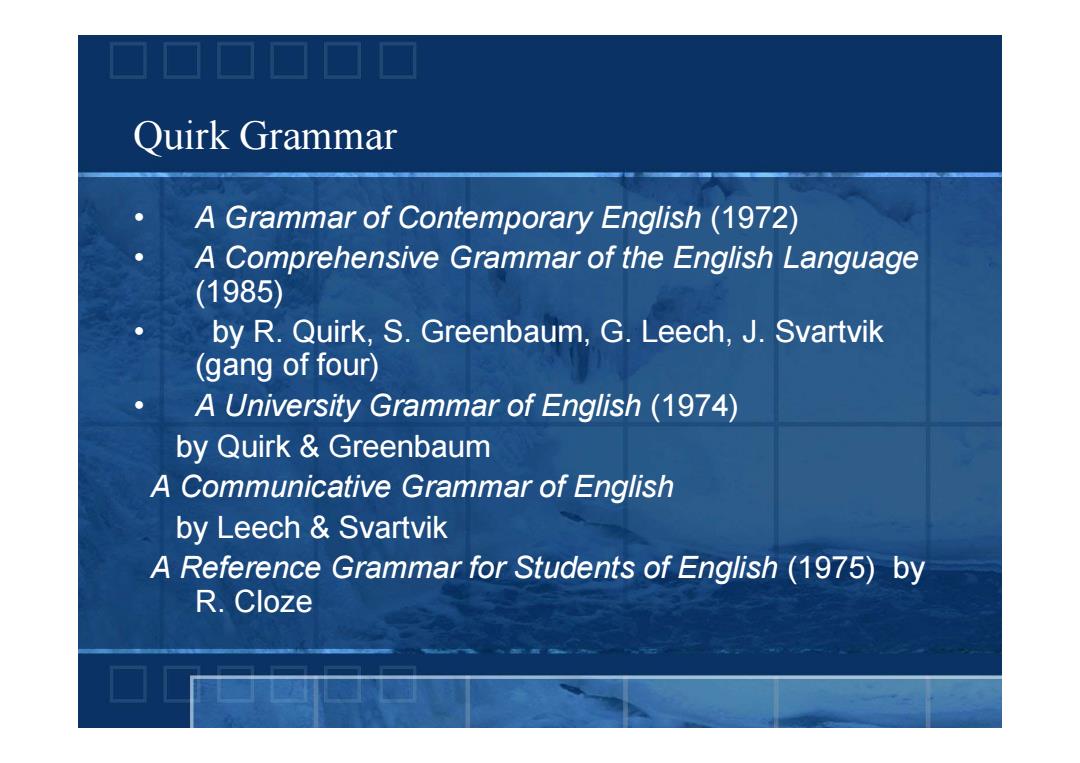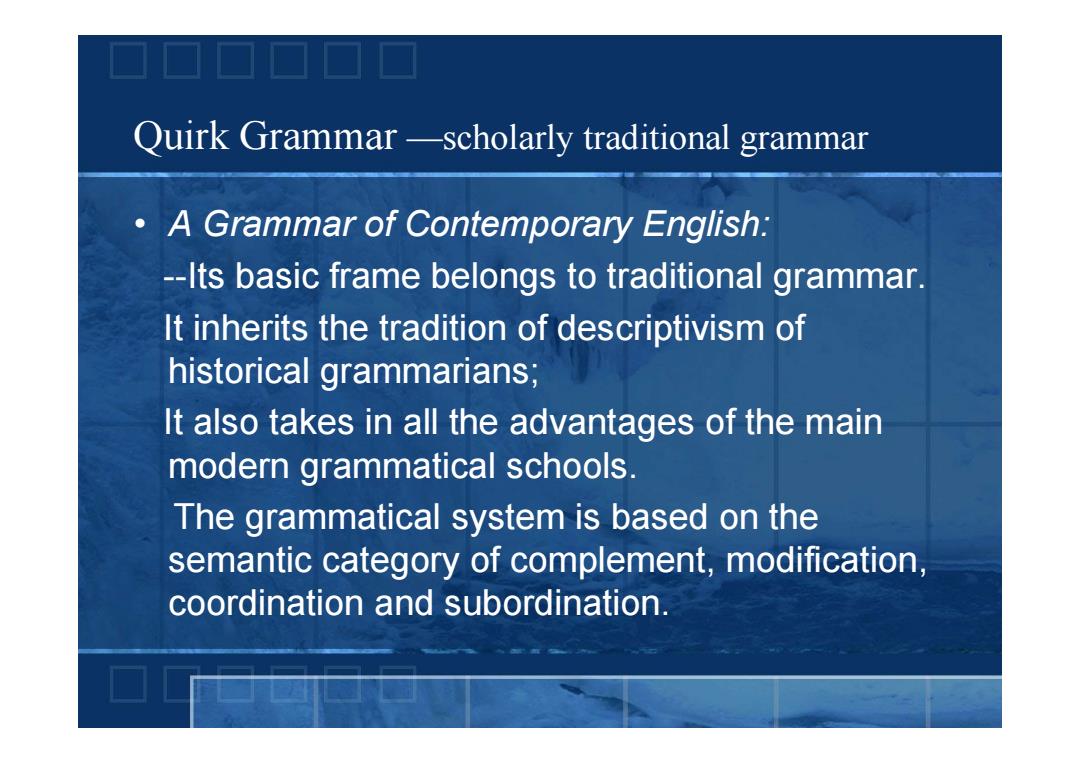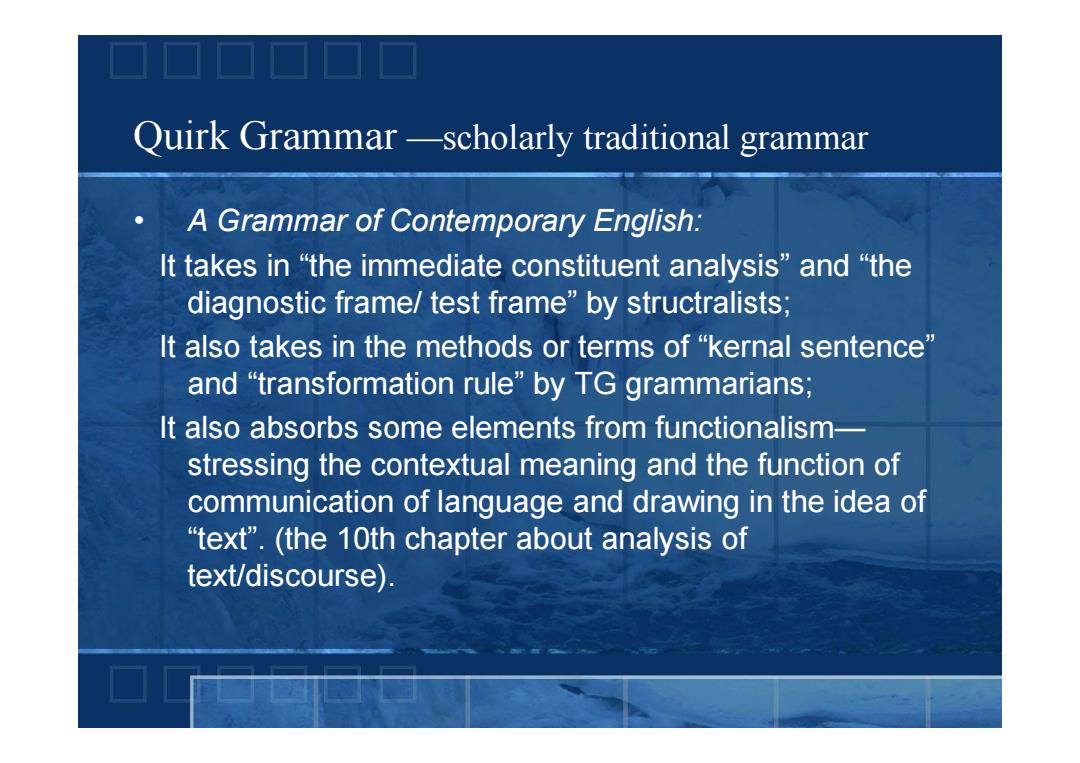
Quirk Grammar A Grammar of Contemporary English(1972) A Comprehensive Grammar of the English Language (1985) by R.Quirk,S.Greenbaum,G.Leech,J.Svartvik (gang of four) A University Grammar of English(1974) by Quirk Greenbaum A Communicative Grammar of English by Leech Svartvik A Reference Grammar for Students of English(1975)by R.Cloze
Quirk Grammar • A Grammar of Contemporary English (1972) • A Comprehensive Grammar of the English Language (1985) • by R. Quirk, S. Greenbaum, G. Leech, J. Svartvik (gang of four) • A University Grammar of English (1974) by Quirk & Greenbaum A Communicative Grammar of English by Leech & Svartvik A Reference Grammar for Students of English (1975) by R. Cloze

Quirk Grammar-scholarly traditional grammar A Grammar of Contemporary English: --Its basic frame belongs to traditional grammar. It inherits the tradition of descriptivism of historical grammarians; It also takes in all the advantages of the main modern grammatical schools. The grammatical system is based on the semantic category of complement,modification, coordination and subordination
Quirk Grammar —scholarly traditional grammar • A Grammar of Contemporary English: --Its basic frame belongs to traditional grammar. It inherits the tradition of descriptivism of historical grammarians; It also takes in all the advantages of the main modern grammatical schools. The grammatical system is based on the semantic category of complement, modification, coordination and subordination

Quirk Grammar-scholarly traditional grammar A Grammar of Contemporary English: The classification of parts of speech of words is based on the morphological,functional and semantic standards simultaneously in the frame of 8 parts of speech (v.:tense/aspect/voice/mood; n.:number/gender/case; art.;pron.;num.;adj.;adv.;prep. Syntax is still in the frame of simple and compound or complex sentences
Quirk Grammar —scholarly traditional grammar • A Grammar of Contemporary English: The classification of parts of speech of words is based on the morphological, functional and semantic standards simultaneously in the frame of 8 parts of speech (v.: tense/aspect/voice/mood; n.: number/gender/case; art.; pron.; num.; adj.; adv.; prep. ) Syntax is still in the frame of simple and compound or complex sentences

Quirk Grammar-scholarly traditional grammar A Grammar of Contemporary English: It takes in“the immediate constituent analysis”and"“the diagnostic frame/test frame"by structralists; It also takes in the methods or terms of "kernal sentence and "transformation rule"by TG grammarians; It also absorbs some elements from functionalism- stressing the contextual meaning and the function of communication of language and drawing in the idea of "text".(the 10th chapter about analysis of text/discourse)
Quirk Grammar —scholarly traditional grammar • A Grammar of Contemporary English: It takes in “the immediate constituent analysis” and “the diagnostic frame/ test frame” by structralists; It also takes in the methods or terms of “kernal sentence” and “transformation rule” by TG grammarians; It also absorbs some elements from functionalism— stressing the contextual meaning and the function of communication of language and drawing in the idea of “text”. (the 10th chapter about analysis of text/discourse)

Quirk Grammar-scholarly traditional grammar A Grammar of Contemporary English: As for the tenses:two tenses:past and present; no future tense but expressions of future time. As for the aspects:two aspects:progressive and perfective. As for the adverbial,the authors divide it into adjunct,disjunct,and conjunct
Quirk Grammar —scholarly traditional grammar • A Grammar of Contemporary English: As for the tenses: two tenses: past and present; no future tense but expressions of future time. As for the aspects: two aspects: progressive and perfective. As for the adverbial, the authors divide it into adjunct, disjunct, and conjunct